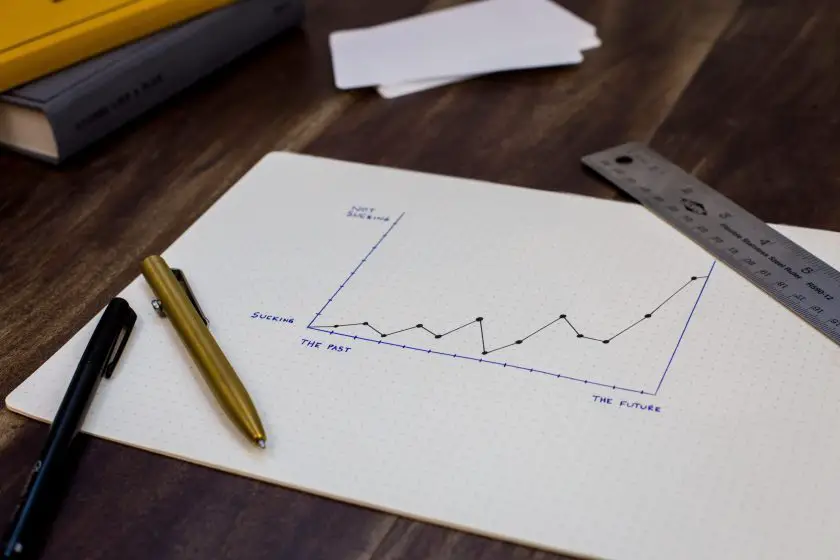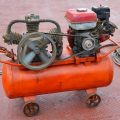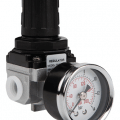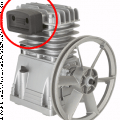It’s possible that a tool you have requires greater CFM than your compressor is capable of providing in order to operate effectively. In this case, there are multiple available methods for your to adjust your air compressor system in order to increase the CFM.
This article will present to you some methods on how you can tweak your compressed air system to provide the desired amount.
Table of Contents
Hey! This site is reader-supported and we earn commissions if you purchase products from retailers after clicking on a link from our site.
Increasing Air Compressor CFM
In order to increase the CFM available to draw from the outlet, you can either increase the pumping capacity or increase the air storage capacity of your compressed air system. You cannot of course increase the specified CFM of your compressor pump without conducting modifications to the pump.
That’s another thing though, we’re focusing on increasing the CFM we’re able to draw from the air compressor tank outlet not the CFM of the pump itself. This is explained in more detail in our Calculating CFM Of An Air Compressor Outlet And Pump article!
The need to add more pumping capacity or more storage capacity will depend heavily on whether your tools require intermittent or continuous use. Short periods of intermittent use will allow you to increase CFM by increasing the storage capacity and generally will provide more options than continuous demand. For continuous demand, adding extra air storage will not suffice, your only option is increasing the pumping capacity of the system to get that additional CFM.
Regardless of the intermittent or continuous demand of air for your tools, you must be aware that your compressor is likely to be designed for intermittent use itself. This is air compressor duty cycle, formally expressed as a percentage. If you have a compressor with a 50% duty cycle (which is very popular), your compressor can only work for say 10 or 20 minutes and then it must rest for that same amount of time.
More on air compressor duty cycle can be found here.
How to Increase Air Compressor CFM
So what are the best methods for increasing air compressor CFM? In short:
- Adding a second air receiver tank
- Adding a second compressor
- Decreasing pressure to increase CFM
- Increasing the size of the existing compressor
Now let’s take a look at each in more detail!
Adding a Second Air Receiver Tank
The addition of a second air receiver tank into the compressed air system will offer you a far greater amount of stored air. This will result in longer periods of tool operation because the motor will need to run for a longer time to reach its cut-out pressure.
Now that the compressor is filling a great volume of air, you have more CFM available for your high-demand air tools. This is of course an oversimplification, as this method will not increase the CFM of the system, but only the amount available for a certain period of time.
It is, therefore, possible to get 10 CFM from an air compressor system that has a 5 CFM rated pump, as long as you have an adequate amount of storage tanks. This 10 CFM would only be available for a short period of time, however, as the 5 CFM rated compressor pump would not be able to keep up with this additional demand.
The addition of a second air receiver tank not only gives you greater storage but also allows your compressor to have a lengthier cooling downtime which is a great way to reduce the compressor’s stress. The greater volume of air enables you to run your tools for longer before the tank pressure drops to its cut-in pressure where the motor kicks start again.
Considerations
It’s extremely important that your compressor does not exceed its duty cycle. The addition of a second tank will help decrease the working vs resting time ratio, which even if the pump is working for longer, will reduce the duty cycle somewhat. This technique is therefore great for reducing the duty cycle whilst delivering the required CFM of your air tools.
You must be conscious that this will cause you to have to stop-start frequently if you wish to continuously draw down air. The compressor will require a lengthier period of time to refill the air tanks when the pressure drops to the cut-in, this could lead to you having to wait around in order to use the tool again.
Therefore, this method is more suited to intermittent applications, where the compressor pump has time to keep up with the workload. This can also help avoid any premature maintenance issues. If you were to run your compressor outside of its specified duty cycle, you’re running the risk of permanent damage to multiple components including the motor or pump.
So if we were to compare smaller and bigger air tank volumes, notable differences would be:
- the smaller the tank the smaller the periods of continuous use
- the bigger the tank the bigger the periods of continuous use
A small tool like an impact wrench is a tool that would see short periods of continuous use, while a wet spraying gun may require longer periods of continuous CFM demand. Therefore, the latter would require an air compressor with enough storage and a duty cycle suitable for providing that CFM, or a pump that is rated for the specific CFM of the gun.
So, to summarise this method of increasing cfm:
- Cost effective in that you only need to purchase an addtional tank
- Great for intermittent use
- Must ensure duty cycle is not exceeded
- Not ideal for continuous use
- Tank must be sized suitable for either intermittent or continuous use
Adding a Second Compressor
Adding a second compressor is not a straight forward as it sounds. You have a compressor that is exactly the same brand, model and CFM output, a different compressor that has the same CFM, a same brand compressor that has a different CFM and, a different compressor with a different CFM. There are a lot of options with in this method and so, I will not cover every possibility. Instead I will break the options into two separate methods:
- Adding a second compressor of the same brand, model & CFM
- Adding a second compressor of a different brand, model & CFM
Adding a Second Compressor of the Same Brand, Model & CFM
This method of adding a second compressor of the same brand, model & CFM will double your available CFM without any complexity over control. The method allows you to increase the CFM of the systems pumping system (as you now have 2 pumps) while also prooviding the higher CFM at the air compressor tank/regulator outlet. It ticks all boxes.
The two compressors can be connected rather easily, all you need is to have both compressors connecting to a tee air fitting. Here you can connect your air line leading to your air tools at the outlet of the tee. Another advantage of this method is that they’ll both be factory set to the same cut-in and cut-out pressures, allowing you to simply connect them and go! No need to overcome any synchronising of control issues.
Considerations
This method could be considered a rather drastic approach if you do not require continuous use for this doubled CFM. It may be worth just buying a new compressor with the CFM capabilities you require as it may cost a similar amount or possibly even less!
Let’s not forget the duty cycle of these compressors, you will still need to ensure that you’re not overworking the compressors.
To summarize this method:
- Factory settings (pre-set) should allow you to avoid synchronising control issues
- Great for continuous use air tool demands
- Not very cost effective as you must purchase a second compressor
- Suitable for intermittent use air tool demands
Adding a Second Compressor of a Different Brand, Model & CFM
Similar connection process equal to the last method but this time you’re connecting a compressor of a different brand, model & CFM which brings forward multiple challenges. So let’s imagine, you have a 15 CFM compressor and you’ve now come across a 10 CFM compressor in storage which is in perfect working condition.
You decide to connect the outlets of the two air recievers to a t-piece fitting and then connect your hose to this outlet to connect to your air tools… You now have a compressed air system that can provide 25 CFM of continous flow rate!
Considerations
Income the difficulties, it’s extremely likely that the pressure settings are going to be completely different. So you will need to overcome the synchronising control issues in order to set the cut in and cut out pressures to the exact same numbers.
If the cut-in pressure of one of the compressors is lower than the other, the compressor with the higher cut-in pressure will begin working earlier than the one with the lower cut-in pressure and this can prove problematic going forward. You must prevent one of the compressors from doing all the work and get the true potential out of your system by setting the cut-in and cut-out pressures as the same.
This gap between the cut-in pressures will result in increased maintenance requirements and a shorter life-span for the compressor that is doing the majority of the work. Not only this but in order to obtain peak CFM, both compressors must be operating prior to cutting out and their tanks, 99% full. This will not be possible unless the cut-in and cut-out pressures are fully synchronised.
Let’s say they’re not and the 15 CFM compressor has a higher cut-in pressure. The tank is 99% full but the CFM capability of the system is 15 CFM plus the air tanks delivery capacity, rather than the 25 CFM. So, what is the point connecting them together? If you want the full 25 CFM (peak) capability plus the tanks delivery capacity, then you know what to do, synchronise them!
It may be necessary to fit pressure switches on both compressors so that you can synchronise them. For information on Compressor Pressure Switch Adjustment, visit our article where the process is best described! Again, let’s not forget the duty cycle of these compressors, you will still need to ensure that you’re not overworking the compressors and it’s highly possible they may have varying duty cycles which could become an issue.
In summary:
- Adjustable pressure switches required
- Cost effective if second compressor is found or borrowed
- Great for continuous use air tool demands (higher CFM)
- Probably not as cost effective as buying a new compressor
Decreasing Pressure to Increase CFM
With air pressure being increased inside an air compressor (the process of compressing air), it then is forced out the outlet at any given flow rate which can be defined as CFM – volume/time. Each compressor has a pump, which has a power rating, typically in horsepower HP, and the power is equal to the pressure multiplied by the CFM.
Power remains constant as you cannot alter the compressors power beyond it’s limits, however, it is possible to reduce the systems pressure which in turn, will increase the CFM. This is relatively common knowledge but for those who aren’t aware, your compressors tank/regulator outlet’s CFM varies depending on the outlet pressure that has been set.
For example, most compressors are rated “x” CFM at 90 PSI, and something greater at 45 PSI. For this example we’ll say a compressor is rated 5 CFM at 90 PSI, but if you regulate the pressure to 45 PSI then it is possible to get 6 or 7 PSI which may be the difference between you succesfully operating your tools or not (if they can run at that pressure of course).
This inversely proportional relationship between CFM and PSI at the outlet of your air compressor creates adjustment opportunites within reason. You must ensure you look at your air tools requirements, because if their working pressure is lower than 90 PSI, you will get a small boost of CFM if you were to lower the pressure.
Considerations
The relationship between CFM & PSI is extremely complex, you will not be able to calculate the CFM of your compressor at specific pressures unforturnately. This method isn’t suitable for drastic increases in CFM, but only minor adjustments where suitable.
This method is very limited to situations where the compressor is capable of delivering the required CFM at lower pressures than the standard CFM rating at 90 PSI. And therefore, this is probably not suitable for most continuous use air tool demands.
It may be possible to get away with an underrated compressor (higher CFM at lower pressure) if you’re not continuously drawing down higher CFM than your pump is capable of producing. The air compressor tank in this instance acts as a reservoir, allowing the compressor breathing space and a chance to catch up between cycles. Make sure you do not exceed the compressors duty cycle though!!
This method may only get a fraction of the way to supplying the full compressed air flow demand of your tools but it can certainly be of aid to intermittent use projects.
In summary:
- Most cost effective method of all
- Relies on have a sufficiently lower working pressure below 90 PSI to increase the CFM
- Suitable for intermittent use air tool demands
- Suitable for continous use air tool demands only if the compressor CFM exceeds that of the tools requirement
Increasing the Size of the Existing Compressor
A final method, and one I won’t dive too deep into, is increasing the size of the compressor pump to one that boasts greater CFM. You can not increase the size or power of the motor, as the motor is not the part that generates the CFM, the pump is. Increasing the motor will only result in an oversized motor that is too powerful for the smaller pump.
Considerations
Though it may be marginally cost effective to retrofit a new compressor pump and motor to an existing tank, depending on your tank size and age. In many cases it may be better and more cost effective to just buy a new air compressor. One that has the CFM requirements you’re seeking. You must ensure that you conduct thorough research before making any changes to your air compressor, to ensrure your compressor is capable of undergoing them.
| Method | Suitable for Continuous or Intermittent Use | Must additional parts be purchased? | Difficulty Level (Easy, Moderate, Hard) |
|---|---|---|---|
| Adding a Second Air Receiver Tank | Continuous and Intermittent | Yes | Moderate |
| Adding a Second Compressor | Continuous and Intermittent | Yes | Hard |
| Decreasing Pressure to Increase CFM | Intermittent | No | Easy |
| Increasing the Size of the Existing Compressor | Continuous and Intermittent | Yes | Moderate |
FAQs (Frequently Asked Questions)
Yes, but this is an oversimplification. It is possible to add a second air tank to your compressed system to have a greater storage capacity of air. So, this does not increase the CFM of the compressed air system but instead, increases the amount available for a certain period of time, providing you with more CFM available for your air tools. You must be conscious of the face that the compressor will now run for a longer period of time in order to fill the larger volume of air, reaching cut-out pressure slower and potentially exceeding it’s duty cycle.
No, CFM and PSI are inversely proportional to one another. So if you were to reduce the PSI of an air compressor system, you will slightly increase the CFM of the compressors outlet. It’s common knowledge that your the CFM at your air compressors tank outlet varies depending on the outlet pressure that is set. E.g. a compressor is rated at 5 CFM @ 90 PSI and 6 CFM @ 50 PSI.
Yes, it is possible to combine any two compressors for more CFM, whether they’re the same brand, model and CFM or completely different. Of course, each variation will come with its own separate considerations but in general, you can connect the tank outlets of two compressors to a tee, and have a hose connected to the outlet of the tee which heads towards your air tools. You must ensure that the compressors are synchronised so that they cut-in and cut-out at the same pressures.
To increase your air compressor CFM you can try adding a second air receiver tank, adding a second compressor whether that be the same kind or completely different, decreasing the pressure to increase CFM or, increasing the size of the existing compressor by replacing the pump with one of higher CFM. Each method has a lot of steps and considerations you must thoroughly understand before going forward with. This article will provide you with all the relevant information!
It is possible, with the quickest way being filling up the tank a lot faster, so essentially increasing the pressure so that the CFM decreases (inversely proportional). However, you must be careful to not exceed your compressors maximum operating pressure and provide your tool with adequate operating pressure as well as, ensuring the CFM is still suitable for the attached tool.
If you have any questions regarding how to increase CFM on an air compressor, please leave a comment below, with a photo if applicable, so that someone can help you!







I have read everything I can (on your site as well as others) about this example and don’t (yet) feel like I have read the whole answer. I will try to be as specific as possible:
My compressor is 8 gln, 150 max psi, 1.5 running hp, rated for 4.1 scfm @ 90 psi. I want to run a 15# soda blaster rated for 7 cfm @90 psi.
Based on your post “Adding a Second Air Receiver Tank” (above), please correct or confirm my thinking: If I tie-in an 11 gln tank (rated for 125 max psi), with a check valve flowing from Compressor Pump (“Tank A”, set to no less than 125 psi) to the 11 gln tank (no pump; “Tank B”), then to another regulator (set to tool psi = 90 psi) then to tool, will I be able to get my 7 cfm?
Apologies in advance but, I will figure out the CFM based on your post “Calculating CFM Of An Air Compressor Outlet And Pump” later. I just thought I’d shoot you a quick one first.
Besides the CFM calculations, my example seems to reverse your suggested configuration for a single pump setup. So, my implicit question based on this setup is: Does treating the Tank B reservoir as the “tool supply” present any limitations/advantages I should know about? (i.e.: Am I going to burn-up my compressor?)
Thanks,